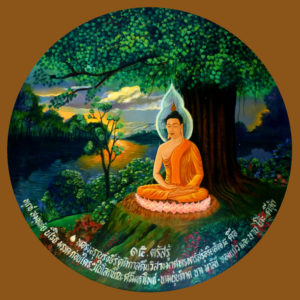Buddhism is a philosophy focused on bringing about the end of suffering through the attainment of Nirvana or Enlightenment, by following the Eightfold Path, understanding the Four Noble Truths and observing the teachings of Siddartha Gautama, the Buddha.
Siddartha Gautama was born into a royal family in the 6th century, the son of Suddhodana, who ruled over land in what is now modern-day Nepal. Accustomed to the lavish lifestyle that royal status brings, the prince was sheltered very strongly from the stresses and sorrows of the world around him, and it wasn’t until he was nearly thirty that he witnessed human suffering for the first time. This shock led him to leave his kingdom, his new wife and his newborn son to understand and find a way to end the suffering he was now acutely aware of.
His ensuing meditative practices – first as an ascetic monk, and later as a simple man of meditation – led him to the profound realization of the way to end suffering, both in everyday life and in one’s spiritual life, in order to remove oneself from the cycle of reincarnation as understood in Hindu tradition.
Siddartha Gautama, who was said to have attained Nirvana at the age of thirty-five, dedicated the remainder of his life to preaching his insights to the world, culminating in the formation of the Buddhist philosophy.
 Buddhism finds many of its roots in the Hindu religion, which the Buddha himself was raised to follow before his own break with tradition. Of the many aspects of Hinduism, those principles of the greatest importance to Buddhism are Karma, Dharma and The cycle of Reincarnation.
Buddhism finds many of its roots in the Hindu religion, which the Buddha himself was raised to follow before his own break with tradition. Of the many aspects of Hinduism, those principles of the greatest importance to Buddhism are Karma, Dharma and The cycle of Reincarnation.
Karma, the idea that every action performed by an individual will cause some effect in that same person’s life – either in this one or the next – is of supreme importance in Buddhism. This is because it is this constant cause-and-effect relationship which an individual has with his or her actions that forces the cycle of reincarnation and, therefore, the cycle of suffering, to continue.
Because of the need to extinguish the karmic cycle in order to attain Enlightenment and the end of suffering, one must adhere to Dharma, a concept central to Hinduism and one which the Buddha preached endlessly. Dharma – “that which upholds or sustains the positive order of things (Dasa, 2007)” – is a kind of sacred duty inherent in the lives of all incarnate, sentient beings according to Hindu teachings, a natural function derived from the Laws of Nature which are said to govern the universe.
The Buddha applied the concept of Dharma specifically toward the goal of understanding the cause of suffering, as well as toward bringing about its cessation.
The cycle of reincarnation
The Buddha understood the cycle of reincarnation, a recurring theme in Hinduism, as being the source for the seemingly endless suffering that those around him experienced. While Hinduism preaches that this cycle is never-ending, Buddhism rejects this notion; Buddhists believe that in attaining Nirvana, one may transcend the cycle of reincarnation altogether.
Though much of Buddhism’s inception grew from the religious teachings of Hinduism, the foundation of the philosophy can be found in the Four Noble Truths and consequently the Eight-Fold Path.
The Four Noble Truths are a brief summary of all of the Buddha’s teachings:
Truth of Suffering
Truth of the Origin of Suffering
Truth of the Cessation of Suffering
Truth of the Way Leading to the Cessation of Suffering

Briefly, these truths state that to live is to suffer, the origin of suffering is attachment not only to physical things but ideas and desires, to relieve suffering one must detach from sensual and earthly cravings and the path to the end of suffering is, of course, the Eightfold Path.
The Eightfold Path is comprised of three categories, Wisdom, Morality and Concentration; these three categories detail the need to constantly strive to better oneself by perfecting one’s understanding of the world and aspirations within it, to be perfect in one’s speech and action and to be mindful and focused in one’s steadfastness to their Dharma and their path to Enlightenment.
Even though all forms which Buddhism has taken rely on these core concepts, there is much variation between the four main types of Buddhism: Theravada, Mahayana, Vajrayana, and Zen.
Theravada Buddhism, the oldest form of the 2,500-year-old philosophy, focuses strongly on the monastic community and by strictly following the teachings of Buddha and the Eightfold Path. Mahayana places less emphasis on the strict adherence to Buddhist texts, focusing more on the necessity of compassion and the bodhisattvas – beings that work to “liberate other sentient beings from their suffering” through compassion; this form of Buddhism is eventually what Zen Buddhism would branch from, placing less emphasis on strict study as on daily meditation and practice to attain Enlightenment.
The final form, Vajrayana Buddhism, focuses on the connection of the physical with the spiritual, preferring rituals and chanting as well as a good understanding of the two preceding forms, in order to attain Enlightenment.
Buddhism is essentially a way of life, a philosophy which places emphasis not on the worship of a deity or deities, but on the ending of suffering through self-improvement and thoughtful action. With its focus on human action as being capable of spiritual salvation, not only of one individual but of others, the unique stance on the human capacity for Enlightenment apart from a divine being draws many – both religious and otherwise – to its teachings and practice.





